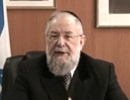Beit Midrash
- Sections
- Chemdat Yamim
- Parashat Hashavua
- Torah Portion and Tanach
- Shmot
- Ki Tisa
In order to express complicated concepts in a simple manner, the Torah uses "key words" or "guiding words." These hint to the one who studies the texts what some of the main themes of the section are. The fact that the root nitzav is used twice in this section, post-Golden Calf, when the root is also found to describe Bnei Yisrael preparing to receive the Torah earlier at Sinai (ibid. 19:17), connects these two periods. Similarly the root is also present in the word matzeva, involved in Bnei Yisrael’s connecting to Hashem at that momentous occasion (ibid. 24:4).
We will suggest that all of these "linguistic" phenomena hint that after the forgiveness granted after the great sin, Hashem’s Presence returned to dwelling among the nation. This is because the root nitzav in many places is used in cases in which the Shechina is present.
When Avraham encountered the three angels after his brit mila, it says that they were nitavim alav (Bereishit 18:2). The famous ladder that Yaakov saw leading to the Heaven was also nitzav on the ground and was followed by Yaakov’s making a matzeva (ibid. 28, 12-18). When Yosef wanted to hint that his dreams were a result of a prophetic vision, he too invoked the verb nitzava (ibid. 37:7).
It is also used when Miriam was standing at a distance, watching what was happening to her baby brother, who was put in the Nile (Shemot 2:4). Chazal therefore stressed that already at that time, Miriam had been serving as a prophetess, saying that her mother would give birth to the savior of Israel. When he was born and the house became filled with light, her father was elated that she seemed right, but when they were forced to put him in the Nile, her father expressed his skepticism. She stood there (with the root of nitzav) to confirm her prophecy, i.e., that which the Divine Presence conveyed to her (see Megilla 14a).
Moving on to Tanach, the gemara (Sota 11a) relates that this root in the story of Hashem’s revelation to Shmuel for the first time was a sign of the presence of the Shechina. Amos (9:1) also tells of Hashem being nitzav on the altar. Finally, Tehillim (82:1) talks of Hashem being nitzav in the presence of a Jewish court. From here, we see that Hashem’s Presence is found in a beit din.
Let us pray that we will experience the return of a palpable Divine Presence, in general, and within the judicial system, specifically, as the pasuk describes the spiritual situation.

You Always Need to Pray
Rabbi Yossef Carmel

Present or Inheritance... or Both?
Various Rabbis | Tevet 5768

Parashat Hashavua: A Rare Commodity – The Right Blend of Unity and Humility
Rabbi Yossef Carmel | Tevet 5786



















